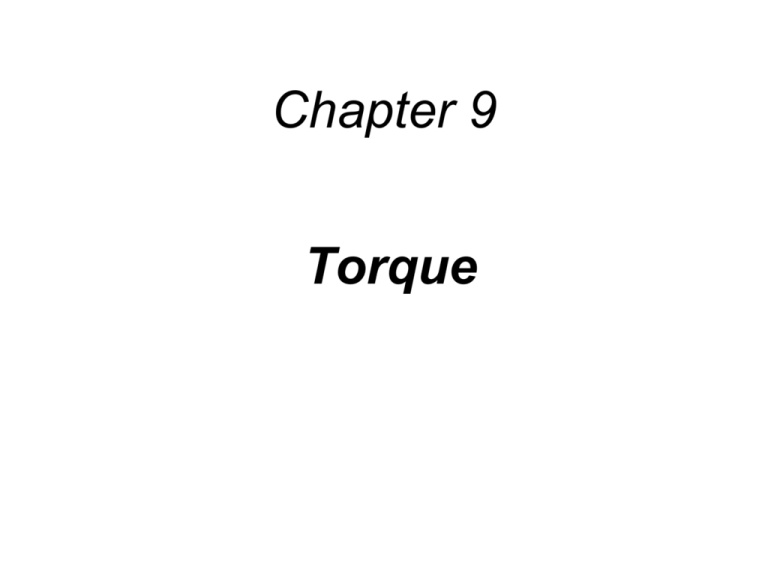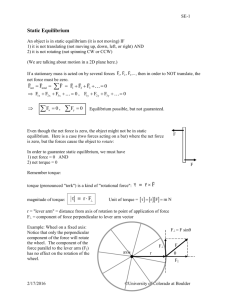Torque
advertisement

Chapter 9 Torque 9.1 The Action of Forces and Torques on Rigid Objects A net force causes an object to accelerate. This is a translational acceleration. What causes a rotational, or angular, acceleration? Opening a door Consider the common experience of pushing open a door. Shown is a top view of a door hinged on the left. Four pushing forces are shown, all of equal strength. Which of these will be most effective at opening the door? The ability of a force to cause a rotation depends on three factors: 1. the magnitude F of the force. 2. the radial distance r from the point of application of the force to the hinge, or pivot. 3. the angle at which the force is applied. Some vocabulary • Line of action, line of force (F) (blue dashed line) – the line along which the force acts. • Axis of rotation (hinge, pivot) – in the examples above, the axis of rotation is out of the page (z axis). More Vocabulary •Radial axis (r) top of the door - in all three the example above, the radial axis is the radius of the circle the door makes as it swings around the hinge. •Lever arm (ℓ) (moment arm) – red dashed line – the line that makes a 900 between the axis of rotation and the line of action. In the first diagram, the lever arm and the radial axis coincide. In the third diagram, there is no lever arm. Magnitude of Torque = (Magnitude of the force) x (Lever arm) F ℓ = r sin θ Where θ is the angle between the line of action and the radial axis Direction of Torque: The torque is positive when the force tends to produce a counterclockwise rotation about the axis. SI Unit of Torque: newton x meter (N·m) 9.1 The Action of Forces and Torques on Rigid Objects The amount of torque depends on where and in what direction the force is applied, as well as the location of the axis of rotation. Rank in order, from largest to smallest, the five torques τa − τe. The rods all have the same length and are pivoted at the dot. (a) (b) (c) (d) (e) Rank in order, from largest to smallest, the five torques τa − τe. The rods all have the same length and are pivoted at the dot. (a) = r sin θ (b) (c) (d) (e) EOC #9 The left end of the meter stick is pinned to the table so the stick can rotate freely parallel to the table top. Two forces, both parallel to the table are applied to the stick. The net torque is zero. The forces and angles are shown. How far from the pivot point (or axis of rotation) is the 6.00 N force applied? EOC #9 - Analysis The drawing below acts as an extended free body diagram. The weight force and the normal force from the table are parallel to the axis of rotation (pivot point), and provide no torque. The 6.00 N force tends to cause cw rotation, so the torque about the pivot from that force is negative. The 4.00 N force tends to cause ccw rotation, so the torque about the pivot from that force is positive. Since the problem states the net torque is zero, these two torques must have an equal magnitude. knowns Find r2 F1 = 4.00N θ1 = 90° F2 = 6.00 N θ2 = 60° r1 = 1 m =זFr(sin θ) EOC #9 - Answer Σ = ז0 ז1 – ז2 = 0 F1r1(sin θ1) – F2 r2 (sin θ2) = 0 4 N(1m) – 6N (r sin 60°) = 0 r = 0.77 m knowns Find r2 F1 = 4.00N θ1 = 90° F2 = 6.00 N θ2 = 60° r1 = 1 m =זFr(sin θ) EQUILIBRIUM OF A RIGID BODY A rigid body is in equilibrium if: F x 0 F y 0 0 This analysis will most likely involve multiple equations with more than one unknown. Reasoning Strategy 1. Select the object to which the equations for equilibrium are to be applied. 2. This is the most important step. Draw an extended free-body diagram that shows all of the external forces acting on the object. You will no longer be able to use a particle to represent the object. 3. Choose a convenient set of x, y axes and resolve all forces into components along these axes. The weight force acts at the center of gravity. Assume the center of gravity is at the mid point of the object, unless told otherwise. 4. Apply Newton’s 1st Law (since ma=0 for equilibrium) in component form. 5. Select a pivot point where one or more of the unknown forces will have a torque of zero. Set the sum of the torques about this axis equal to zero. The pivot you pick does not have to be an actual axis of rotation for this object! 6. Solve the equations for the desired unknown quantities. Example 3 A Diving Board A woman whose weight is 530 N is poised at the right end of a diving board with length 3.90 m. The board has negligible weight and is supported by a fulcrum 1.40 m away from the left end. Find the forces that the bolt and the fulcrum exert on the board. known W - normal force of woman on board, numerically equal to her weight, Lw = 3.90m L2 = 1.4 m Find F1 force of bolt on board F2 force of fulcrum on board A diving board 1. Select the object (the board). 2. Draw a free-body diagram (diagram b). Note the direction of forces. The woman pushes down on the board. The fulcrum pushes up (a normal force) With the woman on the board, the diving board would rotate in a clockwise direction about the fulcrum. What prevents this? The downward force of the bolt. A diving board 3. Choose a convenient set of x, y axes and resolve all forces into components along these axes (All forces are in the y direction –object weight negligible – so true horizonal/ vertical axes are appropriate). y x A diving board 4. Apply Newton’s Law along the y axis: Fy 0 F2 - F1 – W = 0 F2 = F1 + W Both F1 and F2 are unknowns Uh-oh known W - normal force of woman on board, numerically equal to her weight, Lw = 3.90m L2 = 1.4 m Find F1 force of bolt on board F2 force of fulcrum on board y x A diving board 5. Select a pivot point where one or more of the unknown forces will have a torque of zero. The pivot point is not necessarily the point about which the object is most likely to pivot. In this case, we can choose as the pivot point the position of the fulcrum, or the position of the bolt, since they both have one unknown force with a torque of zero about that point (no lever arm). y x A diving board 5 (cont’d) In this problem, we choose the bolt to be the pivot point. Set the sum of the torques about this axis equal to zero. Negative sign is if the force causes the board to rotate cw 0 F 2 2 F2 about the bolt y W W 0 530 N 3.90 m 1480 N 1.40 m x Diving Board F y F1 F2 W 0 obvious that F1 must point down for board to be in equilibrium, so it gets a negative sign in Newton’s 2nd Law F1 1480 N 530 N 0 F1 950 N Walking the Plank Adrienne (50 kg) and Bo (90 kg) are playing on a 100 kg rigid plank resting on the supports shown. How far can Bo walk before the plank tips? (hint, the plank “tips” when it begins to rise up from the left support i.e. when nL = 0). Walking the Plank Adrienne (50 kg) and Bo (90 kg) are playing on a 100 kg rigid plank resting on the supports shown. How far can Bo walk before the plank tips? Using the left support as the pivot point we calculate the sum of the forces and the sum of the torques with n1 = 0. This results in db = 6.3 m, which means Bo can walk 8.3 meters away from Adrienne before the plank begins to tip. Will the ladder slip? A 3.0-m long ladder leans against a frictionless wall at an angle of 60°. What is the minimum value of us that prevents the ladder from slipping? Will the ladder slip? A 3.0-m long ladder leans against a frictionless wall at an angle of 60°. What is the minimum value of us that prevents the ladder from slipping? Answer: us-min = 1/(2 tan 60°) = 0.29 The uniform beam has a weight of 1220 N. It is attached to a vertical wall at one end and is supported by a cable at the other end. A 1960-N block hangs from the far end of the beam. Find: a. The magnitude of the tension in the cable. b. The magnitude of the horizontal c. and vertical components of the force that the wall exerts on the left end of the beam. The uniform beam has a weight of 1220 N. It is attached to a vertical wall at one end and is supported by a cable at the other end. A 1960-N block hangs from the far end of the beam. Find: a. The magnitude of the tension in the cable. 2260N b. The magnitude of the horizontal c. and vertical components of the force that the wall exerts on the left end of the beam. Both = 1450N.





